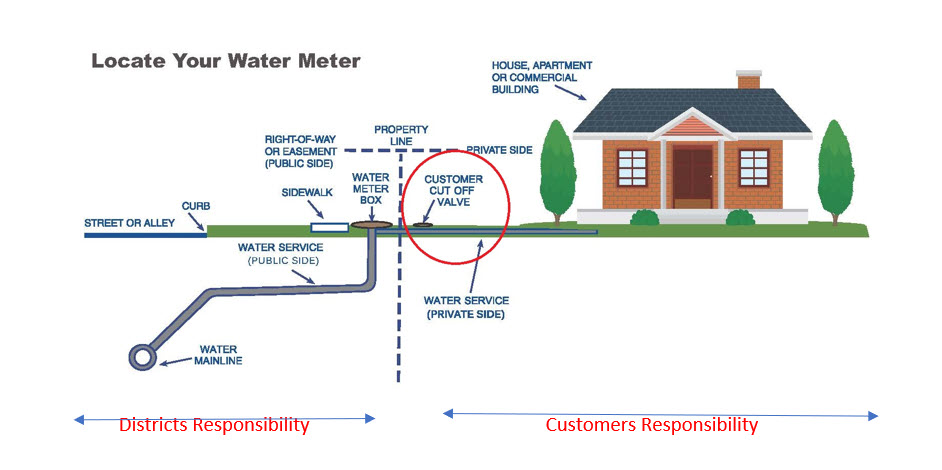This is usually caused by the homeowner’s PRV (Pressure Reducing Valve) going bad. When they go bad, they can start reducing water pressure and sometimes will stop water flow completely. The homeowner will need to call a plumber to replace the valve.
Air forced into the distribution system creates the pressure needed to move water through the pipes. This can result in air bubbles that make tap water appear cloudy or milky. This usually happens after the water has been temporarily shut off. Continue to run the water until the cloudy (air) disappears.
IRIS stands for Immediate Response Information System and is a free, no cost communication tool the District uses to inform customers of any potential water related issues such as a water outage or boil water notice. It is also used to communicate repairs being made around the area that could affect the water. It is important to register and keep your contacts up to date so you don’t miss important information.
A Municipal Utility District, or MUD, is a political subdivision authorized by the Texas Commission on Environmental Quality, (TCEQ), to provide water, sewage, drainage and other services within the MUD’s boundaries. The Travis County Municipal Utility District No. 10 focuses on supplying water and treating wastewater. MUDs are tax-collecting entities with a Board of Directors made up of residents, elected by residents.
While the water meter records every gallon used, you are only billed in increments of 1,000 gallons. When the meter is read, the meter reader reads only in thousands. If you use within the 1,000-gallon range of water each month your bill will be the same.
A minus sign indicates that you have a credit balance, and you do not need to make a payment.
Example: if you bill shows –$26.36 you do not need to make a payment.
Your bill is based off how much water passes through your meter. The meter is read generally every 30 days. Some causes for high bills are: size of home or yard, pool use, irrigation leak, size of household, intermittent running toilets, possible leak.
If you live in a single family home, your meter is electronic, so you can sign up for EyeOnWater (EOW).
Payment was not received and posted to your account prior to your new bill being mailed out. If you have made a payment that is not reflected on your bill you may check your account online or call the office to verify that it was received.
Deposits are applied to any outstanding balance on the account, any remaining amount will be mailed to the forwarding address that was provided when customer called to cancel service.
It’s free to sign up for electronic statements. To pay online, there is a 3% convenience fee to pay online using your credit or debit card, or a $1.00 fee to pay via ACH (entering in your routing and account number).
Most customer shut off valves are located in the front of the home, near the street. There are usually two separate customer shut off valves, one for you and one for your next door neighbor. Look the for District’s meter box (but do not try to open it). Once you see the District’s meter box, your customer shut off valve will be nearby within 6’.
Locate your customer shut off valve, not water meter. The water meter belongs to the District.

Travis County MUD No.10 draws water from Lake Travis and produces quality drinking water for customer consumption.
All public water systems are required to follow the standards and regulations set by the Environmental Protection Agency (EPA). In addition, the Texas Commission on Environmental Quality (TCEQ) is an environmental agency for the state that ensures compliance with Texas public water systems.
The District contracts with Si Environmental, an experience utility company with licensed water and wastewater operators.
The Environmental Protection Agency (EPA) and the Texas Commission on Environmental Quality (TCEQ) are responsible for making sure public water supplies are safe within the US and Texas. There are laws and regulations for the licensed operators to follow. In addition, there are many tests (daily, monthly, quarterly, and annually) that are submitted with licensed laboratories to ensure quality water.
The Lower Colorado River Authority (LCRA) requires all water systems that draw water from the lakes to implement a twice per week irrigation schedule to ensure we have enough water to provide water for domestic use inside the home. Water conservation is essential to protecting this precious resource. When the combined storage level of Lakes Travis and Buchanan drop below 1.1m acre-feet, the LCRA and the District will implement their Drought Contingency Plan (DCP). As the levels continue to decline, the watering restrictions will tighten to help preserve water for in home use. The DCP may be found on the District’s website under the Documents tab.
Visit the Water Conservation tab of the District’s website.
The customer is responsible for anything from the water meter to the home. The District is responsible for anything from the main water line to the meter.
Customers pay a monthly grinder pump fee that is listed on their billing statements. The District is then responsible for repairing or replacing anything from the grinder pump panel to the grinder pump. Customers are responsible for taking care of their sewer system by not pouring grease down drains, and by only flushing waste and toilet paper. Customers could be charged for additional repairs due if proper care is not taken.
No. Disposable wipes take years to disintegrate where toilet paper dissolves in minutes. Too many wipes will clog the system and cause damage which may ultimately impact the customers.
Visit PattyPotty.com to learn more.


